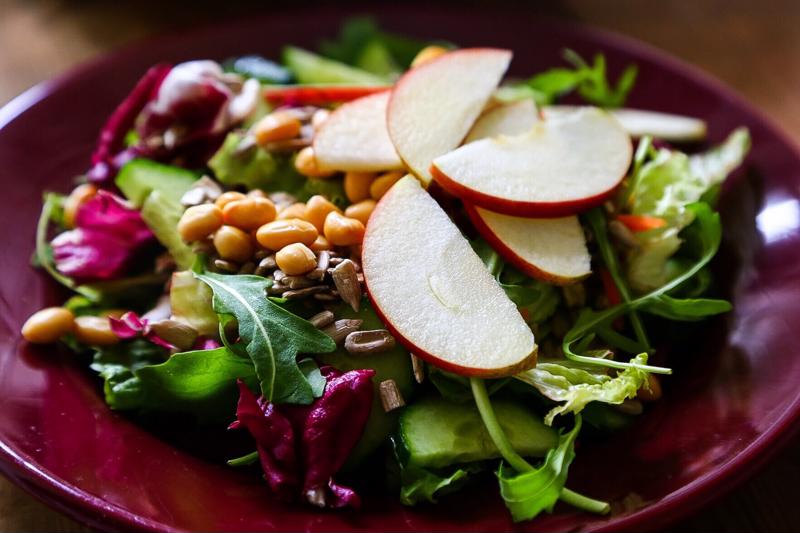All too often, salad is an afterthought – whatever vegetables are readily available tossed with a simple vinaigrette. But if you’re enrolled in an accredited online culinary institute, it’s time you explored some of the flavorful possibilities for fresh produce and other ingredients. When you put a little more thought into your salad, you can capture a fantastic array of flavors. Then this otherwise perfunctory dish can become an appetizer that starts off a meal experience on just the right note or even be satisfying all by itself.
Toss a great salad
Making a great salad is all about picking the right blend of elements, so every bite is delicious and it all comes together with an enjoyable texture. Bon Appetit broke down the commonly used ingredients into five categories. Of course there are the veggies, starting with your choice of greens, and the dressing, whether creamy or a vinaigrette.
“Great salad is about the right blend of taste and texture.”
After you decide on those basics, however, there’s still plenty of opportunity to experiment. You can include proteins like meat and cheese or crunchy items such as croutons, nuts or seeds. Then there’s a whole array of optional extras including fresh fruits, grains and herbs.
To start improving your own salads, take a look at the techniques used by professionals. As Serious Eats pointed out, a good restaurant makes salad quite differently from most home cooks. The distinction begins with adding more flavor with both seasoning, like pouring on the salt, and a generous helping of fats, like olive oil or even bacon fat. Further, chefs in professional kitchens have the resources to prepare large batches of tasty ingredients, whereas it takes more effort for home cooks to plan ahead. One step everyone can take, however, is mixing everything thoroughly in a large bowl that results in evenly distributing the dressing and other elements.
 With fresh, tasty seasonal ingredients, salads can truly impress diners.
With fresh, tasty seasonal ingredients, salads can truly impress diners.Where the salads are super
If you’re contemplating how to step up your salads, there are a great many restaurants out there to offer inspiration. These establishments continue to find creative flavor combinations and intriguing ways to assemble their dishes, producing salads that are worth getting excited about.
With three locations, M Cafe specializes in bringing macrobiotic cuisine to Californians, including several choices of salad. LA Weekly declared the gluten-free M Chop the best around the city for its delicate balance of romaine hearts and mesclun with avocado, cucumbers, chickpeas, herb-baked tofu, scallions, pickled radishes, carrots, tempeh bacon and roasted beets and almonds in a tofu-peppercorn ranch dressing. Those who enjoy seafood with their veggies can opt for a salmon caesar salad featuring grilled fish, little gem lettuce, shaved fennel, sea beans, almond parmesan cheese, garlic croutons and an arugula pesto.
At Garrison in Washington, D.C., chef Rob Weland always has an assortment of fresh, seasonal produce on hand. In the summer, diners have choices like an heirloom carrot salad with Marcona almonds, golden raisins, carrot-top pesto and verjuice. They can also select a dish of caramelized fennel accompanied by lemon, dill, garlic and goat cheese.
Estela, a Mediterranean-inspired New York City eatery, offers an endive salad with anchovies, walnuts and ubriaco rosso, an aromatic cow’s milk cheese from Italy. There’s also a dish of celery joined by raisins, pistachios and blue cheese.
Meanwhile, New Yorkers at Somtum Der choose from nine different spicy salads drawing on the traditions of Thai cuisine. The larb moo consists minced pork, chili peppers and greens. The larb hed kao kuo brings mushrooms, lime, peppermint and roasted rice to the table.
Chicago’s Bar Pastoral is best known for a selection of fine, house-made charcuterie and cured meats. However, as Time Out noted, the bistro also serves hearty seasonal salads. For the warm months, there’s a shaved summer squash salad featuring tomato, lime, pickled beets, goat cheese and strawberry syrup. Patrons can also share a charred peach salad made with arugula, nectarines, sheep’s milk cheese and a Champagne vinaigrette.
However you choose to make a salad your own, you can draw on your culinary academy training to ensure you end up with an irresistible combination of flavors and textures. With fresh vegetables and intriguing additions, salad can stand on its own as a great dish.


